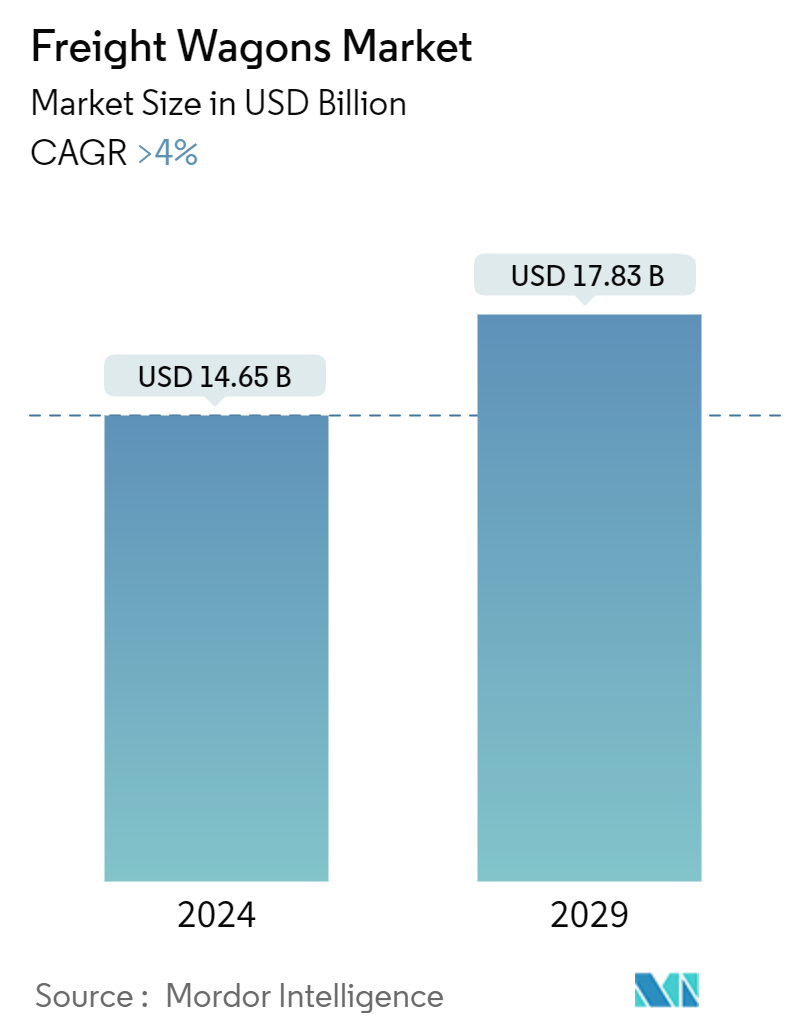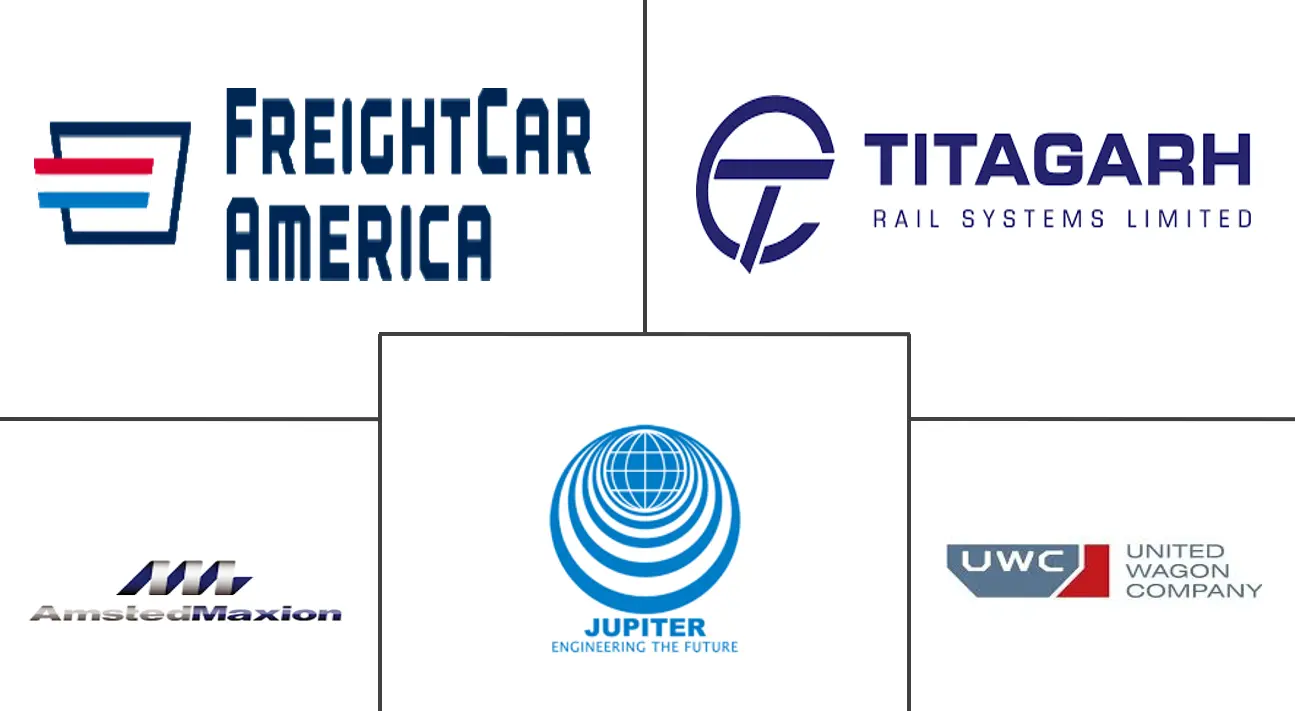Market Size of Freight Wagons Industry

| Study Period | 2019 - 2029 |
| Market Size (2024) | USD 14.65 Billion |
| Market Size (2029) | USD 17.83 Billion |
| CAGR (2024 - 2029) | > 4.00 % |
| Fastest Growing Market | Asia Pacific |
| Largest Market | North America |
| Market Concentration | Low |
Major Players
*Disclaimer: Major Players sorted in no particular order |
Freight Wagons Market Analysis
The Freight Wagons Market size is estimated at USD 14.65 billion in 2024, and is expected to reach USD 17.83 billion by 2029, growing at a CAGR of greater than 4% during the forecast period (2024-2029).
The increasing demand for efficient and cost-effective transportation solutions for goods and commodities is one of the key factors driving the global freight wagon market. According to data from the International Union of Railways (UIC), rail freight transport has been steadily growing in recent years, with a significant portion of global trade being carried out by rail. This trend is expected to continue fueling the demand for freight wagons, a vital component of the rail logistics ecosystem.
Moreover, environmental concerns and sustainability initiatives are also driving the shift toward rail transport, which is considered a more eco-friendly mode of transportation than road or air freight. Rail transport produces lower emissions per tonne-kilometer of freight transported. As a result, governments and industries worldwide are investing in rail infrastructure and rolling stock, including freight wagons, to support the growth of rail freight transport and achieve sustainability goals.
However, the freight wagon market also faces challenges, such as the high upfront cost associated with purchasing and maintaining freight wagons. Additionally, the market is highly dependent on economic factors such as GDP growth, trade volumes, and industrial production, which can impact freight demand and, consequently, the demand for freight wagons. The COVID-19 pandemic, for example, led to disruptions in global supply chains and a temporary decline in freight volumes, affecting the market adversely.
Despite these challenges, there are multiple opportunities for growth in the form of technological advancements, such as developing lightweight materials, improved braking systems, and telematics solutions. Additionally, the rise of digitalization and automation in rail logistics, including the implementation of predictive maintenance and autonomous operation systems, is revolutionizing how freight wagons are managed and operated.
Hence, the freight wagons market is expected to grow significantly during the forecast period owing to the growing rail freight requirement and demand from across the regions.
Freight Wagons Industry Segmentation
A freight wagon, also known as a freight car or goods wagon, is a type of railway vehicle designed to transport goods, cargo, or freight over long distances. These wagons typically consist of a robust, flatbed, or enclosed structure mounted on wheels and equipped with couplings to connect to locomotives or other wagons.
The freight wagon market is segmented by wagon type, payload capacity, axle, and geography. The market is segmented by wagon type, such as closed wagon, open wagon, hopper wagon, flat wagon, tank wagon, car wagon, refrigerated wagon, and special purpose wagon. The market is segmented by payload capacity, which is up to 60 tons and above 60 tons. The market is segmented by axle as 2-axle, 2x2 axle, 4-axle, and 6-axle. By geography, the market is segmented as North America, Europe, Asia Pacific, and the rest of the world). The report offers market size and forecasts for all the above segments in value (USD).
| Wagon Type | |
| Closed Wagon | |
| Open Wagon | |
| Hopper Wagon | |
| Flat Wagon | |
| Tank Wagon | |
| Car Wagon | |
| Refrigerated Wagon | |
| Special Purpose Wagon |
| Payload Capacity | |
| Up To 60 Tons | |
| Above 60 Tons |
| Axle | |
| 2-Axle | |
| 2x2 Axle | |
| 4 Axle | |
| 6 Axle |
| Geography | |||||||
| |||||||
| |||||||
| |||||||
|
Freight Wagons Market Size Summary
The freight wagon market is poised for significant growth, driven by the increasing demand for efficient and cost-effective transportation solutions for goods and commodities. Rail freight transport has been steadily expanding, with a substantial portion of global trade being conducted via rail, which is expected to continue fueling the demand for freight wagons. This growth is further supported by environmental concerns and sustainability initiatives, as rail transport is considered more eco-friendly compared to road or air freight. Governments and industries worldwide are investing in rail infrastructure and rolling stock, including freight wagons, to enhance rail freight transport and meet sustainability goals. However, the market faces challenges such as high upfront costs and economic dependencies, which can impact demand. Despite these challenges, technological advancements and the rise of digitalization and automation in rail logistics present opportunities for growth, revolutionizing the management and operation of freight wagons.
Hopper wagons dominate the freight wagon market due to their versatility and efficiency in transporting bulk commodities like coal, ore, grains, and aggregates. These wagons are essential in sectors such as mining, agriculture, construction, and energy, offering rapid loading and unloading processes that enhance supply chain productivity. Technological advancements have further improved hopper wagons, making them more efficient and cost-effective. The Asia-Pacific region is emerging as the fastest-growing market, driven by rapid industrialization, urbanization, and initiatives like China's Belt and Road Initiative, which boost rail freight transport demand. Environmental concerns also encourage a shift from road to rail transport in the region. The market is fragmented, with key players investing in advanced technologies and collaborations to gain a competitive edge, ensuring continued growth and innovation in the freight wagon industry.
Freight Wagons Market Size - Table of Contents
-
1. MARKET DYNAMICS
-
1.1 Market Drivers
-
1.1.1 Growing Shift Toward Rail Freight Transport is Driving the Market
-
-
1.2 Market Challenges
-
1.2.1 High Initial Cost and Investment is a Big Challenge
-
-
1.3 Porters Five Forces Analysis
-
1.3.1 Threat of New Entrants
-
1.3.2 Bargaining Power of Buyers/Consumers
-
1.3.3 Bargaining Power of Suppliers
-
1.3.4 Threat of Substitute Products
-
1.3.5 Intensity of Competitive Rivalry
-
-
-
2. MARKET SEGMENTATION
-
2.1 Wagon Type
-
2.1.1 Closed Wagon
-
2.1.2 Open Wagon
-
2.1.3 Hopper Wagon
-
2.1.4 Flat Wagon
-
2.1.5 Tank Wagon
-
2.1.6 Car Wagon
-
2.1.7 Refrigerated Wagon
-
2.1.8 Special Purpose Wagon
-
-
2.2 Payload Capacity
-
2.2.1 Up To 60 Tons
-
2.2.2 Above 60 Tons
-
-
2.3 Axle
-
2.3.1 2-Axle
-
2.3.2 2x2 Axle
-
2.3.3 4 Axle
-
2.3.4 6 Axle
-
-
2.4 Geography
-
2.4.1 North America
-
2.4.1.1 United States
-
2.4.1.2 Canada
-
2.4.1.3 Rest of North America
-
-
2.4.2 Europe
-
2.4.2.1 Germany
-
2.4.2.2 United Kingdom
-
2.4.2.3 France
-
2.4.2.4 Rest of Europe
-
-
2.4.3 Asia-Pacific
-
2.4.3.1 India
-
2.4.3.2 China
-
2.4.3.3 Japan
-
2.4.3.4 South Korea
-
2.4.3.5 Rest of Asia-Pacific
-
-
2.4.4 Rest of the World
-
2.4.4.1 South America
-
2.4.4.2 South Africa
-
2.4.4.3 Rest of the World
-
-
-
Freight Wagons Market Size FAQs
How big is the Freight Wagons Market?
The Freight Wagons Market size is expected to reach USD 14.65 billion in 2024 and grow at a CAGR of greater than 4% to reach USD 17.83 billion by 2029.
What is the current Freight Wagons Market size?
In 2024, the Freight Wagons Market size is expected to reach USD 14.65 billion.

